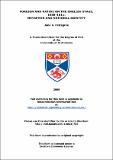Files in this item
Foreign and native on the English stage, 1588-1611 : metaphor and national identity
Item metadata
| dc.contributor.advisor | Davis, Alex | |
| dc.contributor.author | Pettegree, Jane | |
| dc.coverage.spatial | vi, 382 p. | en |
| dc.date.accessioned | 2009-11-20T09:59:23Z | |
| dc.date.available | 2009-11-20T09:59:23Z | |
| dc.date.issued | 2009-06-23 | |
| dc.identifier | uk.bl.ethos.552240 | en_US |
| dc.identifier.uri | https://hdl.handle.net/10023/786 | |
| dc.description.abstract | This thesis explores the role of metaphor in the construction of early modern English national identity in the dramatic writing of Shakespeare and his contemporaries. The metaphorical associations of character names and their imagined native or foreign stage settings helped model to English audiences and readers not only their own national community, but also ways in which the representation of collective ‘Englishness’ might involve self-estrangement. The main body of the thesis comprises three case studies: Cleopatra, Kent and Christendom. These topographies -- personal, local and regional -- illustrate how metaphorical complexes shifted against both an evolving body of literary texts and under pressure from changing historical contexts, variously defining individual selves against the collective political nation. Each section explores inter-textual connections between theatrical metaphors and contemporary English non-dramatic texts, placing these within a wider European context, and ends by discussing a relevant play by Shakespeare (Antony and Cleopatra, King Lear and Cymbeline respectively). The first case study examines ways in which Cleopatra was used as a metaphor to define individual against collective identity. I shall suggest that such Oriental self-alienation might be seen as enabling; Cleopatran identities allow English writers, readers and audiences to imagine aesthetic alternatives to public identities. The second case study looks at the idea of Kent as an emblematic identity that both preserved local peculiarity while providing a metaphor for collective English identity. Writers use Kentish ambiguity to explore discontinuities and uncertainties within the emerging political nation. The third case study examines the idea of Christendom, used as an imaginary geography to bridge the gap between individual and political identities. I suggest that attempts to map Christendom to literal territorial coordinates might be resisted in ways that produced, again, alternative, non-national literary identities. | en |
| dc.language.iso | en | en |
| dc.publisher | University of St Andrews | |
| dc.rights | Creative Commons Attribution-NonCommercial-NoDerivs 3.0 Unported | |
| dc.rights.uri | http://creativecommons.org/licenses/by-nc-nd/3.0/ | |
| dc.subject | National identity | en |
| dc.subject | Shakespeare | en |
| dc.subject | Metaphor | en |
| dc.subject | Drama | en |
| dc.subject.lcc | PR658.M56P4 | |
| dc.subject.lcsh | Metaphor in literature | en |
| dc.subject.lcsh | National characteristics, English, in literature | en |
| dc.subject.lcsh | English drama--Early modern and Elizabethan, 1500-1600--History and criticism | en |
| dc.title | Foreign and native on the English stage, 1588-1611 : metaphor and national identity | en |
| dc.type | Thesis | en |
| dc.contributor.sponsor | Arts and Humanities Research Council (AHRC) | en |
| dc.type.qualificationlevel | Doctoral | en |
| dc.type.qualificationname | PhD Doctor of Philosophy | en |
| dc.publisher.institution | The University of St Andrews | en |
This item appears in the following Collection(s)
Except where otherwise noted within the work, this item's licence for re-use is described as Creative Commons Attribution-NonCommercial-NoDerivs 3.0 Unported
Items in the St Andrews Research Repository are protected by copyright, with all rights reserved, unless otherwise indicated.


